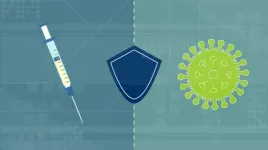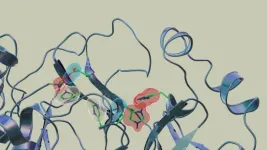(Press-News.org) Potentially paves way for non-invasive diagnostic test at all levels of participation
On a par with the assessment currently provided in professional sports
Could work alongside 'gold standard' head injury protocol used in elite sports
Distinct chemical 'signatures' for concussion have been identified in the spit of elite male rugby players, reveals research published online in the British Journal of Sports Medicine.
This potentially paves the way for a non-invasive and rapid diagnostic test for the condition that could be used pitch side and after the game at all levels of participation, suggest the researchers.
This is especially important because concussion can be hard to diagnose, particularly at grass-roots level, where most of it occurs, but where gold standard medical assessment by trained clinicians during and after a game isn't readily available, they add.
As a result, a high percentage of concussions are missed, and concerns have emerged about the long-term brain health of athletes exposed to repeated concussions.
The short term consequences of a missed diagnosis range from a prolonged recovery period, often with protracted and pervasive symptoms, to a heightened risk of further injuries, including catastrophic brain swelling, although this is rare, emphasise the researchers.
In the absence of objective diagnostic tests for concussion, diagnosis currently relies on a clinician's interpretation of the observed signs and symptoms, and the results of formal clinical assessments.
But recent technological advancements in gene sequencing have allowed scientists to look into the diagnostic potential of molecules called small non-coding RNAs, or sncRNAs for short. sncRNAs regulate the expression of different cellular proteins that are linked to various diseases, such as cancer and Alzheimer's disease.
So the researchers obtained saliva samples from more than 1000 male professional players in the top two tiers of England's elite rugby union across two seasons (2017-19) of competition.
Samples were collected before the season began from 1028 players, and during standardised 'gold standard' head injury assessments at three time points--during the game, immediately afterwards, and 36-48 hours later in 156 of these players.
Saliva samples were also collected from a comparison group of 102 uninjured players and 66 who had sustained muscle or joint injuries, and so had not been assessed for head injury.
A combined panel of 14 sncRNAs differentiated concussed players from those with suspected traumatic brain injury, but whose head injury assessments had ruled out concussion, and from the comparison group, both immediately after the game and 36-48 hours later.
This is an observational study, and the study design makes it clear that the sncRNA biomarkers can't outperform the gold standard clinical assessment, caution the researchers.
But it is thought that saliva can receive cellular signals directly from cranial nerves in the mouth and throat, and so can rapidly register traumatic brain injury, making a saliva test particularly suitable for a pitch side diagnosis, they suggest.
"Concussion can be hard to diagnose and is often missed, especially where a structured evaluation by an expert clinician is not possible--for example, at grass-root level," they write. "Small non-coding RNAs can provide a diagnostic tool that might reduce the risk of missing this type of injury at all levels of participation," they suggest.
"In community sport, [sncRNAs] may provide a non-invasive diagnostic test that is comparable in accuracy to the level of assessment available in a professional sport setting," while the test could be added to current head injury evaluation protocols at the elite level," they add.
And as the biology of concussion is still not fully understood, sncRNAs might help to shed light on the response to injury as this evolves over time, they suggest.
"The detection of signatures of concussion at early time points in saliva (a non-invasively sampled biofluid) presents both at the pitch side, and in primary care and emergency medicine departments, an opportunity to develop a new and objective diagnostic tool for this common clinical presentation," they conclude.
*As an addendum to their findings, they add: "A patented salivary concussion test is in the process of being commercialised as an over-the-counter test for elite male athletes.
"Meanwhile our research team aims to collect further samples from players in two elite men's rugby competitions to provide additional data to expand the test and develop its use. This will guide the prognosis and safe return to play after concussion and further establish how the test will work alongside the head injury assessment process.
We are also currently carrying out several additional studies to further validate and expand the test for use in different groups that were not included in the present SCRUM study, including female athletes, young athletes, and community sports players."
INFORMATION:
Externally peer reviewed? Yes
Evidence type: Observational
Subjects: Male athletes
Scientists at the U.S. Department of Energy's Ames Laboratory have observed novel helical magnetic ordering in the topological compound EuIn2As2 which supports exotic electrical conduction tunable by a magnetic field. The discovery has significant implications for basic research into functional topological properties and may one day find use in a number of advanced technology applications.
Topological materials burst onto the scene in the physical sciences about fifteen years ago, decades after their existence had been theorized. Called 'topological' because their bulk electronic bands are "knotted" together, the surfaces of topological insulators "untie the knot" and become metallic. Researchers ...
People who received a flu shot last flu season were significantly less likely to test positive for a COVID-19 infection when the pandemic hit, according to a new study. And those who did test positive for COVID-19 had fewer complications if they received their flu shot.
These new findings mean senior author Marion Hofmann Bowman, M.D., is continuing to recommend the flu shot to her patients even as the flu season may be winding down.
"It's particularly relevant for vaccine hesitance, and maybe taking the flu shot this year can ease some angst about the new COVID-19 vaccine," says Hofmann, an associate professor of internal medicine and a cardiologist at the Michigan ...
While COVID-19 cases may be on the decline, the virus is still prevalent nationwide, and higher education institutions need to prepare for a successful 2021 academic year. New research from Clemson University in The Lancet Child & Adolescent Health, one of the world's premier peer-reviewed general medical journals, indicates how surveillance-based informative testing (SBIT) mitigates the spread of COVID-19 on campus, paving the way for other institutions, even those without the infrastructure or funding for mass-scale testing.
SBIT was implemented during the first two weeks of the Fall semester at Clemson. According to the study, ...
Another step towards understanding Alzheimer's disease has been taken at the Maisonneuve-Rosemont Hospital Research Centre. Molecular biologist Gilbert Bernier, and professor of neurosciences at Université de Montréal, has discovered a new function for the BMI1 gene, which is known to inhibit brain aging. The results of his work have just been published in Nature Communications.
In his laboratory, Bernier was able to establish that BMI1 was required to prevent the DNA of neurons from disorganizing in a particular way called G4 structures. This phenomenon occurs in the brains of people with Alzheimer's disease, but not in healthy elderly ...
Scientists have found new, unexpected behaviors when SARS-CoV-2 - the virus that causes COVID-19 - encounters drugs known as inhibitors, which bind to certain components of the virus and block its ability to reproduce.
Published in the Journal of Medicinal Chemistry, the research provides key insights for advancing drug design and drug repurposing efforts to treat COVID-19.
Researchers at the Department of Energy's Oak Ridge National Laboratory used neutron scattering to investigate interactions between telaprevir, a drug used to treat hepatitis C viral infection, and the SARS-CoV-2 main protease, the enzyme responsible for enabling the virus to reproduce.
They ...
When the human immunodeficiency virus infects cells, it can either exploit the cells to start making more copies of itself or remain dormant--a phenomenon called latency. Keeping these reservoirs latent is a challenge. A new paper, published in the Proceedings of the National Academy of Sciences, has found a way to look for chemicals that can keep the virus suppressed into its dormant state.
"The current drug treatments block healthy cells from becoming infected by the virus," said Yiyang Lu, a PhD student in the Dar lab at the University of Illinois Urbana-Champaign. "The latent reservoir poses a bigger problem because it can start producing the virus at any time. Consequently, patients have to remain on antiretroviral therapy all their lives to prevent ...
Boston - Wearing masks and physical distancing - two key infection prevention strategies implemented to stop the spread of COVID-19 - may have led to the dramatic decrease in rates of common respiratory viral infections, such as influenza. A study led by researchers at Boston Medical Center (BMC) showed an approximately 80 percent reduction in cases of influenza and other common viral respiratory infections when compared to similar time periods in previous years, before wearing masks, physical distancing, and school closures were implemented to help stop the spread of COVID-19. Published online in Open Forum Infectious ...
SAN ANTONIO (March 23, 2021) -- More than half of all health care workers worldwide are experiencing burnout that, if not addressed, could cause many to leave their fields in favor of less-stressful occupations or choose early retirement. And the COVID-19 pandemic has only made it worse.
That's the warning of a surgeon from The University of Texas Health Science Center at San Antonio in a letter and a call for global action published March 22 in the Lancet journal EClinicalMedicine.
"A recent survey done in Medscape of nearly 7,500 physicians globally showed that burnout has reached a very high rate," said END ...
By targeting an enzyme that plays a key role in head and neck cancer cells, researchers from the UCLA School of Dentistry were able to significantly slow the growth and spread of tumors in mice and enhance the effectiveness of an immunotherapy to which these types of cancers often become resistant.
Their findings, END ...
Researchers have succeeded in revealing the arsenal used by protozoans of the genus Leishmania in human cells to make leishmaniasis more severe, especially in cases of the mucocutaneous variety of the disease, which can cause deformations in patients. The discovery points the way to a search for novel treatments for the disease as well as casting light on a key mechanism involved in other diseases.
The mechanism involves Leishmania, macrophages and a virus that lives endosymbiotically in the parasite and is known as the Leishmania RNA virus (LRV). According to a study published in the journal iScience, the parasite inhibits activation of caspase-11 via LRV-induced autophagy. Caspases are a family of enzymes that ...


